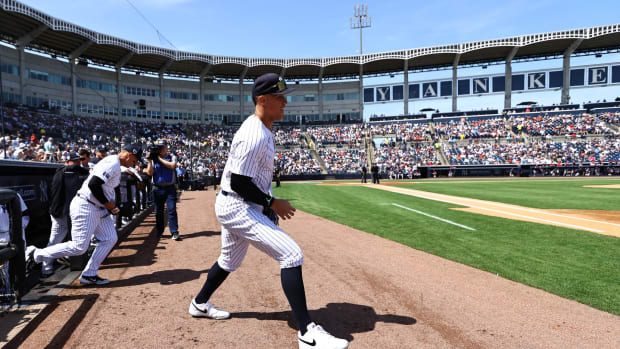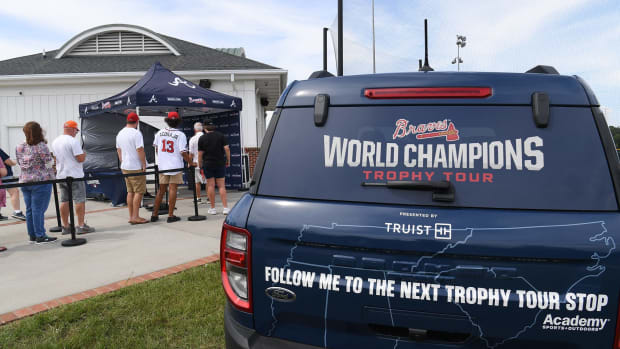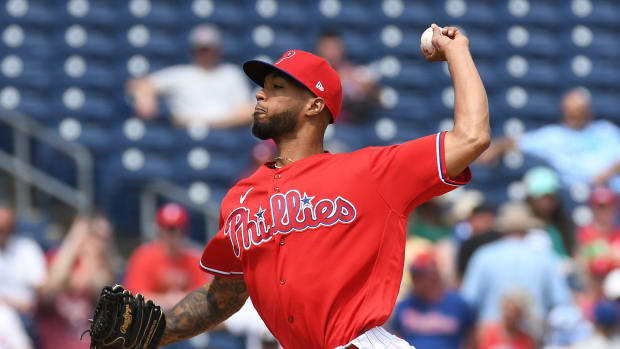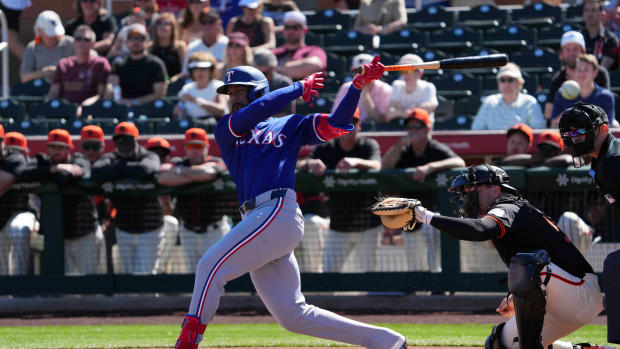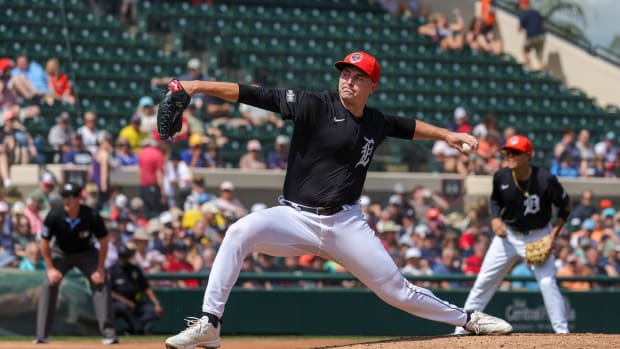'I Want To Be With One Team': Why Bryce Harper Resisted the Lump Sum to Join the Phillies
The most expensive deal in baseball history took root in a casino. The Philadelphia Phillies’ last best chance to woo Bryce Harper took place amid the high-backed gold leather booths and white linens of Carbone, a restaurant in the ARIA resort and casino in Las Vegas that imbues the feel and fragrance of mid-century Hollywood. When it comes to the rare baseball player with star power, a location scout could not do much better for glamour and showmanship to set the scene.
It was a Friday night, Feb. 22, when Phillies owner John Middleton and his wife, Leigh, met with Harper and his wife, Kayla, and his agent, Scott Boras, at Carbone. It was Middleton’s third trip to see Harper in Las Vegas. Philadelphia had been the most aggressive pursuer all along, but fancy linen or not, Harper and Boras were not there to compromise. They wanted to top the $325 million contract of Giancarlo Stanton, the existing record, and they needed three more years out of Middleton to get it done.
Harper, 26, had given Boras strict instructions at the start of his free agency: prioritize length of contract, and don’t bother even asking for opt outs.
“It was not only important not to have an opt out, he refused to allow me to do it,” Boras said. “He said, ‘I want to be with one team.’ I tried to talk him out of it. He gave me my marching orders.”
The dinner included almost no talk about terms.
“I may have said five minutes worth of words the entire time,” Boras said. “John and Leigh, Bryce and Kayla, they just talked.”
Middleton spent most of the time giving his best Chamber of Commerce speech. He talked up the Philadelphia area’s schools, hospitals, restaurants and general quality of life. When the Phillies began their courtship of Harper back in December, they kicked it off with a slickly-produced video in which the club found as many prominent Philadelphians as possible—athletes, politicians, restaurateurs, coaches, business owners, etc.—and had them speak directly to Harper to join them in the city. The video also included marquees of local arenas with his name in lights.
Still, the Phillies were not comfortable offering Harper more than 10 years. He had neither the length nor the record dollars he wanted until the last week in February.
“It took a hell of a long time to get those [last three] years,” Boras said.
Starting with the Friday dinner, it took one last whirlwind of a week for Boras to work his stagecraft and get the years needed to surpass the Stanton contract. On Saturday the Middletons ate with the Harpers again, this time for lunch before John and Leigh zipped back to Florida on their private jet. On Sunday, with the exhaust from Middleton’s jet barely dissipated, a contingent from the Dodgers flew into McCarran Airport in Las Vegas to offer Harper a record amount of money per year, but only on a deal covering four or five years. (The top average annual value bid to Harper was $43 million; Boras would not confirm it was from the Dodgers.) On Tuesday, right behind their divisional rival, the Giants jetted in with a 12-year offer worth around $310 million. All the stagecraft had the desired effect.
On Thursday morning Middleton called Boras to offer $330 million over 13 years. Boras hung up the phone and at 11:34 am PT he called Harper. Kayla joined Bryce on the phone.
“I’ve got it,” Boras said. “I’ve got the terms of the final deal. Just give me the okay and it’s done.”
Bryce and Kayla quickly gave their consent. With that call ended one of the longest and strangest free agent courtships since the concept began in 1976. It also ended not just one winter of free agency, but a full decade of planning for that moment by Boras and Harper since Harper left high school early. It did not end, however, the biggest question that hung over the entire winter: is Bryce Harper worth it?
Boras will tell you he obtained exactly what his client wanted, and set a record by doing so.
“He’s the oldest player to ever get a 13-year contract in sports history,” Boras said. “Bryce’s goals were so unusual for most players. If Bryce wanted a 10-year deal he was offered more money than [Manny] Machado. He would have had opt outs if he wanted. He wanted the length of contract.”
Machado signed a 10-year, $300 million contract with the Padres that gives him an opt out after five years. Harper’s average annual value ($25.4 million) doesn’t even make the top 10 in baseball.
“Bryce took less AAV. He took more years,” Boras said, comparing the deal to the Machado contract. “And we’re playing on a winning team. Bryce Harper wanted to play on a winning team now and one that has the revenues to sustain it. He got all those things. When Manny Machado is 35, let’s see if he gets those millions over the remaining three years. You’d better be a real good defensive player, too. I did it for [Adrian] Beltre.”
To surpass Stanton, what Boras and Harper did essentially was to use the last three years as the equivalent of deferred money to help the Phillies reduce the amount counted toward the Competitive Balance Tax, or luxury tax threshold. That AAV still leaves room for the Phillies to bid on Mike Trout if Trout becomes a free agent after the 2020 season. A club source said before this offseason began that the club had enough money to sign both Machado and Harper, but wanted just one of them in order to keep money in reserve for Trout.
The Phillies are getting a star, especially in name recognition. London-based SportsPro Media ranked Harper last September as the 13th most marketable athlete in the world. Aaron Judge (10) and Shohei Ohtani (33) were the only other baseball players on the list of 50 such athletes. Still, detractors could define Harper as a superstar celebrity without the superstar numbers.
For instance, over the past three seasons, Harper ranks 86th in wins above replacement, making him less valuable by that metric than players such as Corey Dickerson, a guy cut loose by Tampa Bay, and Cesar Hernandez. In a baseball world dedicated to analytics to measure value, Boras had to resort to his old-school ways to get value for Harper: sell teams on the subjectivity of his star value and make a direct connection with ownership, rather than the number-crunchers who build teams.
Before the process even began he lost a huge bargaining chip when Harper’s incumbent team, the Washington Nationals, sent an offer on the last weekend of the regular season. It was reported to be $300 million over 10 years, but included so much deferred money over such a long period—Harper would be 60 years old when the last payments were made—that the net present value was $184 million. The Harper camp saw the offer as little more than a publicity gesture to appease fans.
A source close to the Nationals described how Boras responded: “crickets.” The source said Boras gave no reply to the offer for weeks. The source said Washington GM Mike Rizzo accepted some of the blame for how quickly it fell apart between Harper and the only organization he had known, recognizing that the team had a history of catering to Harper without challenging him.
Harper lost another potential key suitor when the New York Yankees showed almost no interest whatsoever. The Yankees made pitching their offseason priority, and even dabbled in the Machado sweepstakes because they saw more value in the Gold Glove infielder than another power-hitting outfielder. (They already had Giancarlo Stanton and Judge under control through at least 2022 and would soon lock up Aaron Hicks.) Frankly, some teams, such as the Braves, just didn’t see Harper as worth a record contract. “Harper is great friends with Freddie Freeman and would have loved Atlanta,” said one club source, “but [we] just didn’t value him that high.”
“Corner outfield is the easiest place to find a bat,” said one club president. “He doesn’t stand out as much as Machado, a righthanded-hitting third baseman who hits righthanded pitching.”
Said another club executive, “At best, he’s an average defensive player. At best.”
Some worried about how his violent swing would hold up.
“He’s Tiger Woods with that swing,” said one GM. “I’d take him for a few years, but it’s hard to see how that body is going to hold up when you swing like that. You saw how Tiger’s body broke down.”
Boras had to fight the perception that Harper was injury-prone. He met with several teams in December about Harper, and when one executive from one of those teams expressed concern that Harper was not durable, Boras was ready.
“Explain something to me,” the agent said. “Do you think Mike Trout is durable?”
“Oh, sure. Yes,” the executive said.
“Over the last four years, do you know how many plate appearances each of them has?”
“No.”
“Trout has 2,478. Bryce has 2,468. They’re within 10 plate appearances over the past four years.”
Some clubs questioned how Harper hit .214 in the first half of last season and how his defense ranked among the worst outfielders in baseball. Harper never left his feet to attempt a catch all season.
Boras responded to those concerns by explaining that Harper did not have full strength in his knee through the first half of the season. He was on his way to winning a second MVP Award in 2017 when he slipped on a wet base in August, hyperextending his knee. His outfield play, Boras explained, was the result of a kid who grew up as a catcher, who learned how to play the outfield in the big leagues and had to learn from over-aggressive mistakes that put his body at risk.
But in Middleton and the Phillies, Boras found a receptive and eager audience. Philadelphia, the second biggest one-team baseball market (behind only Dallas), was a sleeping giant. The team had suffered six straight losing seasons. Their attendance, though up slightly last season, was down 1.6 million people from their peak in 2010. When Middleton opened the free agent season by declaring his team not only had money to spend but also “maybe even be a little bit stupid about it,” Boras had his mark. The agent has excelled in getting owners to make emotional buys, but that tact has withered in recent years as whip-smart general managers wrested buying control with their cold, analytics-based decision making.
Middleton bought a 15% stake in the Phillies in 1994 for $18 million. He assumed a more active role in the club in 2014 when chairman Dave Montgomery took a medical leave. By November 2016 he was named the team’s designated control person to MLB. In his first offseason in that role he worked out a March deal for another Boras client, Jake Arrieta.
This time, Boras could sell both numbers and also star power.
“The reality is the greatest and most successful aspect of Hollywood are the stars,” Boras said. “George Clooney, Jennifer Lawrence, Bradley Cooper … whatever movie they are in is about them. People identify with the greatest of great people. In sports you think about Michael Jordan and Tom Brady. When you think about the people who are the billboards of teams it creates what we expect in sports. People want to watch greatness and they want to watch the greatness of individuals.
“What is best for baseball is what the fans tell us: when you have the greatest, most iconic players, the fans will come.”
Boras told Middleton how Harper helped the Nationals improve their attendance by 600,000 from before he arrived, tripled their television viewership and improved their franchise value fourfold.
“He will pay for himself,” Boras said.
The first time Middleton met Harper, in January, he was impressed with the way Harper essentially ran the meeting himself. Machado, when he met with Philadelphia, preferred to let his agent run most of the meeting. After Harper rattled off details of the Phillies’ 2008 World Series win—he was in high school then—and how pitchers attack him, Middleton told Boras, “I’ve been around a lot of professional players, but I’ve never seen a player who could talk about the game with such specific recall. This guy is different.”
Boras’s next job was to convince the Phillies that Harper would hold up over more than 10 years. Harper, he told them, was a Mormon who didn’t drink or smoke, and who was both a baseball rat and a gym rat.
“His discipline off the field is amazing,” Boras told them. “He’s on a Hall of Fame track and he’s not a follower.”
Phillies manager Gabe Kapler, who attended the first meeting, is a fitness fanatic who engaged Harper in discussions about training, nutrition and fitness. Two sources familiar with the meeting, however, said that Harper was turned off by Kapler’s intensity. Boras disputed that notion, saying, “They talked, they hit it off. They were two peas in a pod.”
Then Boras brought out his numbers. As much as Boras distrusts the complete faith the modern front office puts in numbers—he likes to say baseball is headed toward “the analytical abyss”—he was an early devotee on selling his clients to teams based on projections from his own army of analysts. Two things about Harper, Boras told all clubs, predict that he will be an elite hitter well through his 30s: his ability to get on base at such a young age, and his ability to crush fastballs.
Harper’s OBP of .388 ranks sixth best among all players with at least 900 games through their age-25 season. The only five to have played that much by that age with a better OBP are Jimmie Foxx, Mickey Mantle, Ty Cobb, Mel Ott and Trout.
As for hitting fastballs, Harper has the freakish ability to look for breaking balls and adjust to velocity—the very opposite of almost all other hitters. The average major league fastball is 93 mph. Hitting against above-average four-seamers last year (94 mph and greater), Harper posted the fourth-best slugging percentage (.695). Over the past four years, he ranks 11th in slugging against high velocity (.551).
“By his OBP at a young age and his bat speed, you’ve got the ability to sustain your performance,” Boras said. “What I love to do is get a player in a place where he can execute well. And he hits fastballs, and the velocity of the NL East fits him. It was really an ideal fit.”
Harper has hit 14 home runs at Citizen Bank Ballpark in Philadelphia, the most of any road ballpark in his career. He has slugged .564 there, the best in the ballpark’s history (min. 200 plate appearances). His new teammate, first baseman Rhys Hoskins, ranks second (.562).
It all seemed like the right fit. But Boras knew something was missing: competition.
Late in the afternoon on Feb. 24, Dodgers owner Mark Walter, president and CEO Stan Kasten, president of baseball operations Andrew Friedman and manager Dave Roberts jumped into Friedman’s SUV at the team’s spring training complex in Glendale, Ariz.
“All of sudden they went off in a hurry and they were out of here,” said one witness. They were on their way to catch a flight to Las Vegas. The competition was about to get serious.
The Dodgers had been playing a stealth game with Harper’s camp, staying out of the headlines but making their interest known to Harper and Boras. They “talked with them off and on again all throughout the winter,” said a source familiar with their strategy. But Los Angeles never discussed the kind of long-term deal Harper wanted.
“We were always more focused on a short term deal,” said one team source. “Shorter term, higher AAV deals.”
Even though Harper had instructed Boras to get a long-term deal that effectively would keep him with one team for the rest of his career, Boras kept the Dodgers engaged. He had called them “four or five days” before the Feb. 24 meeting. They jetted off to Vegas because Boras “cracked the door on that concept,” according to a club source, of a short-term, high AAV deal.
When the news broke that the Dodgers met with Boras and Harper, the Giants reacted. Owner Larry Baer and president of baseball operations Farhan Zaidi were next to jet into McCarran, doing so two days after the Dodgers did. It was their second meeting with the Harper camp in two weeks.
It took four months and 20 trips to Las Vegas from his Orange County base, but now Boras had the auction atmosphere that creates market value in free agency. He had two rivals in the game, with the Dodgers willing to set a record for AAV and the Giants willing to go past 10 years. Now he could return to Middleton to get those last three years that would give Harper the all-time record for most money guaranteed to a player. The Phillies no longer were bidding against themselves.
They began the winter wanting to sign either Machado or Harper. Machado was off the board, with GM Matt Klentak explaining the Padres had gone beyond their evaluation of the player. Now Boras was giving them a clear opening at Harper: hit the number and he’s yours. They did so, without having to worry about Harper opting out and with Harper taking up 15% less of their CBT number than Machado will for the Padres.
The $330 million over 13 years works out to a net present value of about $241 million. That’s still about 31% greater than what the Nationals offered at the end of last season.
“A third of a billion dollars for one player is unbelievable,” said one GM. “You have to start there. The other thing that stands out is that Harper didn’t have preferences. What if he had a preferred destination? Would he have taken less money? Or was it about ego and the record? It seemed all he cared about was breaking the record.
“Thirteen years is giving your whole career over to a place where rumor has it he didn’t like. But maybe Scott was good at creating all kinds of those narratives to get to the number.”
“Harper’s Bazaar” is what back in November Boras called the wooing of Bryce Harper. Boras met with eight teams since the start of February, 10 going back to December. Spring training camps had been open for two weeks by the time Harper finally signed. And when he did, he signed with the perceived frontrunner, a team with a ballpark that allows him to build on the fast start to his career home run totals—he ranks 12th among all players through age-25 season—in a major market with a chance to win immediately.
This is what Harper wanted: to chase records, chase titles, chase endorsements, and chase a legacy with one team rather than becoming a baseball nomad. And this, too: more money in one contract than has ever been handed over to a ballplayer. Ten years in the making, he got what he wanted.
































